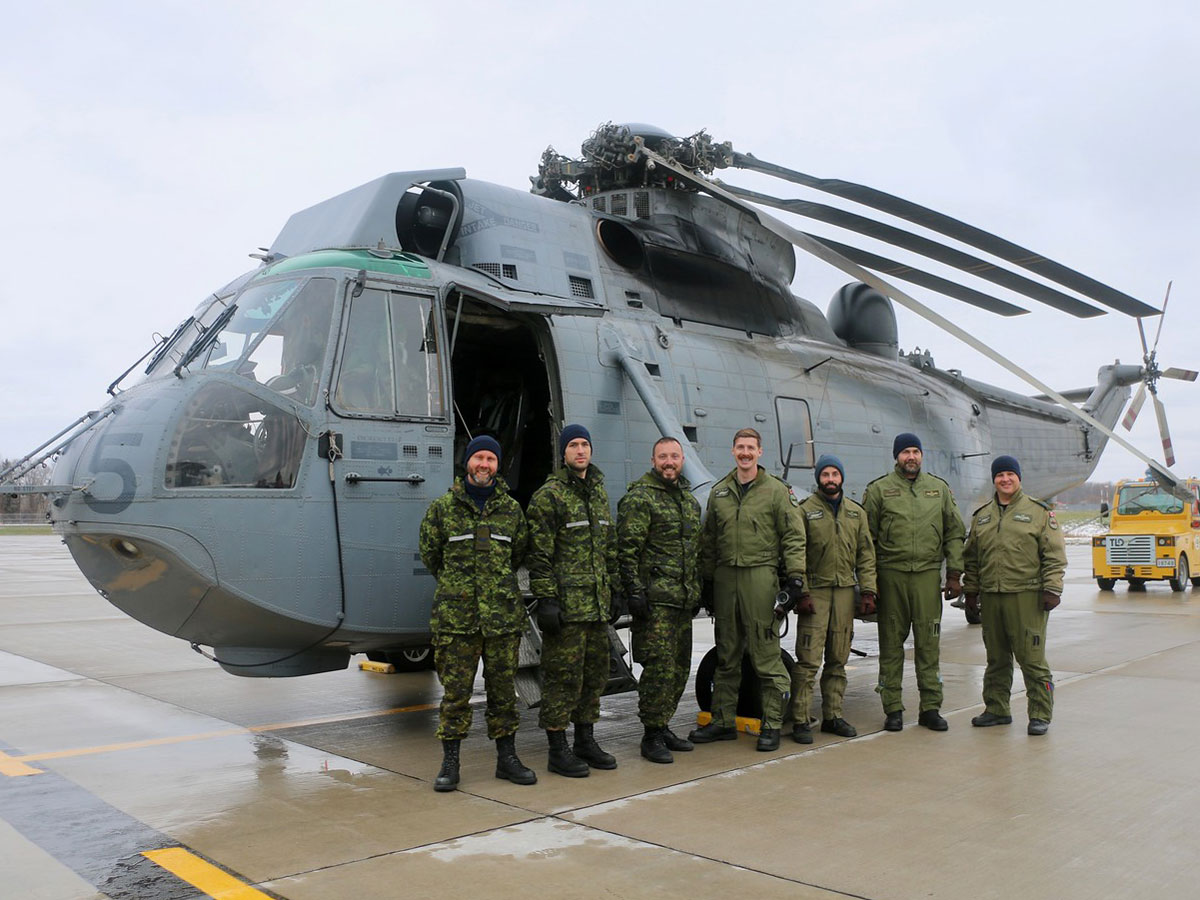Final Flight: Sea King lands in Trenton
By Lookout on Nov 26, 2018 with Comments 0
Makala Chapman, The Contact Newspaper ~
One of the Royal Canadian Air Force’s (RCAF) longest-serving helicopters has landed in Trenton and is now calling Quinte West home.
A modest crowd gathered at 8 Wing Trenton to watch as CH-12405 Sea King emerged from the grey horizon, savouring its final moments of flight on Nov. 20, as this year marks the retirement of the Sea King helicopter.
Having arrived from Patricia Bay, British Columbia, the aircraft will soon be put on display at the National Air Force Museum of Canada (NAFMC), where it will continue to serve as a reminder of Canada’s rich aviation history.
On hand to marshal the maritime helicopter was Wing Chief Warrant Officer Troy Zuorro. While not a normal duty of the Wing Chief, with an extensive career working with the Sea King, he noted it was an opportunity he didn’t want to miss and was honoured to have been a part of the arrival.
First procured by Canada and put to work in 1963, the maritime aircraft has been at the forefront of missions both domestically and abroad, as well as having worked extensively with the Royal Canadian Navy.
Initially tasked with keeping watch for enemy vessels, as the aircraft is equipped with sonar equipment, radar and homing torpedoes, the role of the Sea King eventually broadened.
Boasting a compact design with a fold-up rotor and tail, the Sea King is a versatile aircraft that’s been used for search and rescue (SAR) operations to disaster relief. Overseas, the aircraft has been used during peacekeeping operations to help transport troops and for surveillance.
Since it is maritime aircraft, it operates primarily on the coasts of Canada out of 12 Wing Shearwater, Nova Scotia, and Patricia Bay, B.C.
On hand to watch the arrival of the Sea King was the museum’s executive director Kevin Windsor. He noted that he couldn’t have been more thrilled to have a Sea King join the museum’s current collection and added that CH-12405 was a particularly special acquisition.
“This is historic,” said Windsor. “This was the first Canadian-built Sea King. It’s the iconic helicopter of Canada.”
The first four Sea Kings in service in Canada were built by Sikorsky Aircraft at their factory in Connecticut, whereas CH-12405 was built in Montreal. Windsor went on to share his delight at having a piece of the Maritimes at home in Trenton.
“Not many people around here get to see things like the Sea King or the CP-140 Aurora, which we also have here,” he said. “A lot of the guys at the museum who are working on the aircrafts in the restoration department are old Sea King maintainers and will continue to work on it. They’re really excited.”
But before the museum can have possession of the helicopter, a lot of work goes into ensuring it’s safe to be put on display. That’s where aviation systems technicians (AVN) technicians from British Columbia’s 443 Maritime Helicopter Squadron come in.
Travelling with the Sea King to Trenton was Master Corporal Mac Neilson, an AVN tech. He noted the final journey was bittersweet as it marked the end of an era.
“I’ve worked on this one here on and off for the past 12 years,” he said. “But overall, this aircraft is in really great shape.”
He added he was glad it would be preserved at the museum so its legacy could continue.
“That’s where it should be since that’s where the rest of the history of the air force is,” he shared. “Honestly, I’m very proud to have been part of the final flight because I’ve put a lot of blood, sweat, tears, and hours into it.”
Before it could be handed over to the museum, a safety check was completed. That included removing any explosive carts on emergency equipment, draining nitrogen, stabilizing the blades and any other necessary safety measures. While the aircraft arrived fully serviceable, once on display there will be no potential dangers to the public and it won’t be able to fly.
Also speaking about his fondness of CH-12405, and having taken part in its last journey across Canada, was Major Chris Inchley of 443 Maritime Helicopter Squadron. For the seasoned pilot, this trip was both a historic moment and a milestone in his career.
“I just so happened to break 3,000 hours on the Sea King during this trip,” he said with a smile. “That’s 14 years of flying. We just did the last shut down there and in 12 hours it will be a museum piece. It’s pretty significant.”
As for his favourite part of flying the aircraft, he said it was its maneuverability. Since it’s not electronic, and engaging autopilot isn’t really any option, Maj Inchley noted it’s like the helicopter and the pilot become one.
“It goes where you want it to go and you have to make it do that,” he explained. “What we do with the aircraft is amazing. We can put it on the back of a small ship or we can take 11 technicians and eight aircrew and fly it all over the world in all crazy sea state, day or night. It’s just an amazing aircraft. It always has been and always will be.”
The final trip from B.C. to Ontario took approximately 25 hours. Despite having to wait for some coastal rain in Victoria, B.C., and a snowstorm in Medicine Hat, Alberta, to clear, Maj Inchley said the trip went well. But he’s not done flying the Maritime helicopters just yet. There are still four Sea Kings out west that members of 443 Maritime Helicopter Squadron will use before the helicopter’s final day of service in December.
Filed Under: Top Stories
About the Author:






